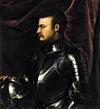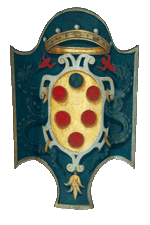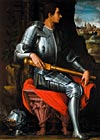
The son felt great veneration towards this figure, making him a true dynastic hero useful also for his own political image. The ceremonial shield on display here is valid evidence of this, a proud self-presentation of the second duke of Florence, Cosimo, probably on the occasion of the marriage to Eleanor of Toledo.
In fact, the Medici armorial bearings, surmounted by the ducal crown, are painted on the large central escutcheon. The arms, however, are those of the more famous extinct branch of Piero and of Lorenzo the Magnificent (in fact, there is no ball with the cross of the people, specifically of the “Popolano” Medici branch to which the young duke also belonged but the azure one with the lilies of France), between two Sforza serpents, the “biscioni”.
It is the obvious self-promotion of a lord who, in a single image, used all the utmost prestige his kinship could offer: the political glory of the Medici in the 15th century and the nobility of the Lords of Milan (the family to which his paternal grandmother Caterina Sforza belonged).

Leggenda dinastica, uno dei personaggi della quale si è, forse, come pietrificato, per mano del Giambologna e per volere di Francesco I, nel giardino della villa di Pratolino ove, appunto, la statua del gigantesco Appennino da cui scaturiscono gelide acque potrebbe essere intesa come mitica creatura ‘mugellana’.

The absolutism of power, finally, celebrated itself with the creation of the grand ducal “Armory”, set up in 1589 at the behest of Ferdinando I in the Uffizi Palace right next to the Tribune that his predecessor and brother, Francesco, had conceived as a precious and peaceful jewel case for the Medici collections of paintings, small bronzes, gems and medals. Other armories, ‘private’ ones, must have then been in the Pitti royal palace and in the various villas where the Medici went hunting.
One of the political strong points of the first grand dukes was, in effect, the rationalization of the ‘state’ army, integrated into the more general modernization of absolutist Tuscany: an active spirit deriving, probably, also from their rustic Mugello origins, always held dear by the dynasty.
It was not by chance that the production of arms and valuable metallic artifacts was one of the boasts of the grand duchy and a not insignificant support for the autonomy of the regional state. Since the 14th century, some centers in Tuscany had developed specific ‘technologies’ and among these must certainly be recalled the Mugello’s Scarperia, where formidable blades and edged and pointed weapons were created.